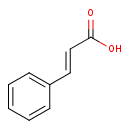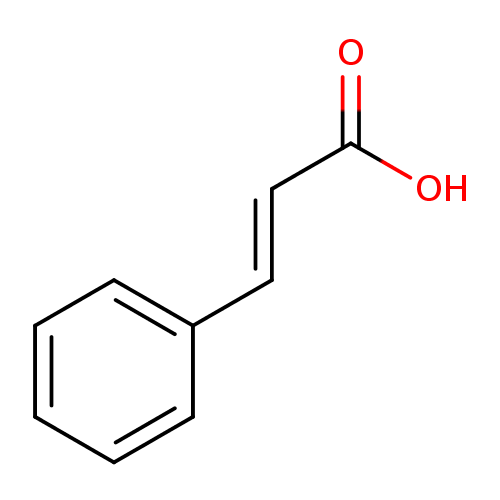|
Record Information |
|---|
| Version |
1.0 |
|---|
| Update Date |
1/22/2018 11:54:54 AM |
|---|
|
Metabolite ID | PAMDB120214 |
|---|
|
Identification |
|---|
| Name: |
trans-cinnamate |
|---|
| Description: | Cinnamic acid has the formula C6H5CHCHCOOH and is an odorless white crystalline acid, which is slightly soluble in water. It has a melting point of 133 degree centigrade and a boiling point of 300 degree centigrade. |
|---|
|
Structure |
|
|---|
| Synonyms: | - (E)-cinnamate
- trans-cinnamate
|
|---|
|
Chemical Formula: |
C9H7O2 |
|---|
| Average Molecular Weight: |
147.153 |
|---|
| Monoisotopic Molecular
Weight: |
148.05243 |
|---|
| InChI Key: |
WBYWAXJHAXSJNI-VOTSOKGWSA-M |
|---|
| InChI: | InChI=1S/C9H8O2/c10-9(11)7-6-8-4-2-1-3-5-8/h1-7H,(H,10,11)/p-1/b7-6+ |
|---|
| CAS
number: |
140-10-3 |
|---|
| IUPAC Name: | (2E)-3-phenylprop-2-enoate |
|---|
|
Traditional IUPAC Name: |
cinnamic acid |
|---|
| SMILES: | C(=O)([O-])C=CC1(=CC=CC=C1) |
|---|
|
Chemical Taxonomy |
|---|
|
Taxonomy Description | This compound belongs to the class of organic compounds known as cinnamic acids. These are organic aromatic compounds containing a benzene and a carboxylic acid group forming 3-phenylprop-2-enoic acid. |
|---|
|
Kingdom |
Organic compounds |
|---|
| Super Class | Phenylpropanoids and polyketides |
|---|
|
Class |
Cinnamic acids and derivatives |
|---|
| Sub Class | Cinnamic acids |
|---|
|
Direct Parent |
Cinnamic acids |
|---|
| Alternative Parents |
|
|---|
| Substituents |
- Cinnamic acid
- Styrene
- Benzenoid
- Monocyclic benzene moiety
- Monocarboxylic acid or derivatives
- Carboxylic acid
- Carboxylic acid derivative
- Organic oxygen compound
- Organic oxide
- Hydrocarbon derivative
- Organooxygen compound
- Carbonyl group
- Organic anion
- Aromatic homomonocyclic compound
|
|---|
| Molecular Framework |
Aromatic homomonocyclic compounds |
|---|
| External Descriptors |
- cinnamates, phenylpropanoid (CHEBI:23248)
- an aromatic carboxylate (CPD-674)
|
|---|
|
Physical Properties |
|---|
| State: |
Solid |
|---|
| Charge: | -1 |
|---|
|
Melting point: |
133 °C |
|---|
| Experimental Properties: |
| Property | Value | Reference |
|---|
| Melting Point | 133 °C | Not Available | | Boiling Point | Not Available | Not Available | | Water Solubility | 0.546 mg/mL | Not Available | | LogP | 2.13 | HANSCH,C ET AL. (1995) |
|
|---|
| Predicted Properties |
|
|---|
|
Biological Properties |
|---|
| Cellular Locations: |
Not Available |
|---|
| Reactions: | |
|---|
|
Pathways: |
- trans-cinnamoyl-CoA biosynthesisPWY-6457
|
|---|
|
Spectra |
|---|
| Spectra: |
| Spectrum Type | Description | Splash Key | |
|---|
| GC-MS | GC-MS Spectrum - GC-EI-TOF (Pegasus III TOF-MS system, Leco; GC 6890, Agilent Technologies) (1 TMS) | splash10-0ue9-0910000000-4a7bcdfadd383bf577dc | View in MoNA |
|---|
| GC-MS | GC-MS Spectrum - GC-EI-TOF (Pegasus III TOF-MS system, Leco; GC 6890, Agilent Technologies) (1 TMS) | splash10-0fb9-6920000000-727a2eb761e6e52fb47d | View in MoNA |
|---|
| GC-MS | GC-MS Spectrum - GC-MS (1 TMS) | splash10-117i-2920000000-f0d9ccc40786362ae4ad | View in MoNA |
|---|
| Predicted GC-MS | Predicted GC-MS Spectrum - GC-MS | Not Available |
|---|
| LC-MS/MS | LC-MS/MS Spectrum - Quattro_QQQ 10V, Positive (Annotated) | splash10-001i-0900000000-3107a2a1bec368528f82 | View in MoNA |
|---|
| LC-MS/MS | LC-MS/MS Spectrum - Quattro_QQQ 25V, Positive (Annotated) | splash10-0ufr-6900000000-b0299d34fa9bb16b8258 | View in MoNA |
|---|
| LC-MS/MS | LC-MS/MS Spectrum - Quattro_QQQ 40V, Positive (Annotated) | splash10-0udi-0900000000-4a879de8ea4f3acb0ae2 | View in MoNA |
|---|
| LC-MS/MS | LC-MS/MS Spectrum - LC-ESI-QQ (API3000, Applied Biosystems) 10V, Negative | splash10-0002-0900000000-88ad8c9c837a057bb2a5 | View in MoNA |
|---|
| LC-MS/MS | LC-MS/MS Spectrum - LC-ESI-QQ (API3000, Applied Biosystems) 20V, Negative | splash10-0udi-0900000000-18280fe18e43043d9e21 | View in MoNA |
|---|
| LC-MS/MS | LC-MS/MS Spectrum - LC-ESI-QQ (API3000, Applied Biosystems) 30V, Negative | splash10-0fb9-9600000000-04d36ba7639bc85e2023 | View in MoNA |
|---|
| LC-MS/MS | LC-MS/MS Spectrum - LC-ESI-QQ (API3000, Applied Biosystems) 40V, Negative | splash10-004i-9000000000-a8417274c4493c5b5871 | View in MoNA |
|---|
| LC-MS/MS | LC-MS/MS Spectrum - LC-ESI-QQ (API3000, Applied Biosystems) 50V, Negative | splash10-004i-9100000000-d3712417826a69667981 | View in MoNA |
|---|
| LC-MS/MS | LC-MS/MS Spectrum - LC-ESI-QTOF (UPLC Q-Tof Premier, Waters) , Positive | splash10-0002-0900000000-37c486fa03918355413c | View in MoNA |
|---|
| LC-MS/MS | LC-MS/MS Spectrum - LC-ESI-QTOF (UPLC Q-Tof Premier, Waters) , Negative | splash10-0f6t-0900000000-218a5babf0ab7c31c498 | View in MoNA |
|---|
| Predicted LC-MS/MS | Predicted LC-MS/MS Spectrum - 10V, Positive | Not Available |
|---|
| Predicted LC-MS/MS | Predicted LC-MS/MS Spectrum - 20V, Positive | Not Available |
|---|
| Predicted LC-MS/MS | Predicted LC-MS/MS Spectrum - 40V, Positive | Not Available |
|---|
| Predicted LC-MS/MS | Predicted LC-MS/MS Spectrum - 10V, Negative | Not Available |
|---|
| Predicted LC-MS/MS | Predicted LC-MS/MS Spectrum - 20V, Negative | Not Available |
|---|
| Predicted LC-MS/MS | Predicted LC-MS/MS Spectrum - 40V, Negative | Not Available |
|---|
| MS | Mass Spectrum (Electron Ionization) | splash10-0f6t-6900000000-77686ecc684f3b46bea6 | View in MoNA |
|---|
| 1D NMR | 1H NMR Spectrum | Not Available |
|---|
| 1D NMR | 1H NMR Spectrum | Not Available |
|---|
| 1D NMR | 13C NMR Spectrum | Not Available |
|---|
| 1D NMR | 1H NMR Spectrum | Not Available |
|---|
| 2D NMR | [1H,1H] 2D NMR Spectrum | Not Available |
|---|
| 2D NMR | [1H,13C] 2D NMR Spectrum | Not Available |
|---|
|
|---|
|
References |
|---|
| References: |
- Boulat O, Gradwohl M, Matos V, Guignard JP, Bachmann C: Organic acids in the second morning urine in a healthy Swiss paediatric population. Clin Chem Lab Med. 2003 Dec;41(12):1642-58. [14708889 ]
- Blanquet S, Meunier JP, Minekus M, Marol-Bonnin S, Alric M: Recombinant Saccharomyces cerevisiae expressing P450 in artificial digestive systems: a model for biodetoxication in the human digestive environment. Appl Environ Microbiol. 2003 May;69(5):2884-92. [12732562 ]
- Sarkissian CN, Shao Z, Blain F, Peevers R, Su H, Heft R, Chang TM, Scriver CR: A different approach to treatment of phenylketonuria: phenylalanine degradation with recombinant phenylalanine ammonia lyase. Proc Natl Acad Sci U S A. 1999 Mar 2;96(5):2339-44. [10051643 ]
- Wahl HG, Hong Q, Stube D, Maier ME, Haring HU, Liebich HM: Simultaneous analysis of the di(2-ethylhexyl)phthalate metabolites 2-ethylhexanoic acid, 2-ethyl-3-hydroxyhexanoic acid and 2-ethyl-3-oxohexanoic acid in urine by gas chromatography-mass spectrometry. J Chromatogr B Biomed Sci Appl. 2001 Jul 15;758(2):213-9. [11486831 ]
- Larue C, Munnich A, Charpentier C, Saudubray JM, Frezal J, Remy MH, Rivat C: An extracorporeal hollow-fiber reactor for phenylketonuria using immobilized phenylalanine ammonia lyase. Dev Pharmacol Ther. 1986;9(2):73-81. [3956347 ]
- Olivera ER, Carnicero D, Jodra R, Minambres B, Garcia B, Abraham GA, Gallardo A, Roman JS, Garcia JL, Naharro G, Luengo JM: Genetically engineered Pseudomonas: a factory of new bioplastics with broad applications. Environ Microbiol. 2001 Oct;3(10):612-8. [11722541 ]
- Lee HS, Beon MS, Kim MK: Selective growth inhibitor toward human intestinal bacteria derived from Pulsatilla cernua root. J Agric Food Chem. 2001 Oct;49(10):4656-61. [11600003 ]
|
|---|
| Synthesis Reference: |
Zhu, Min; Shentu, Chao; Zhou, Zhong Shi. Microwave-assisted base-free synthesis of trans-cinnamic acids using hypervalent iodonium salts. Chinese Chemical Letters (2007), 18(3), 272-274. |
|---|
| Material Safety Data Sheet (MSDS) |
Download (PDF) |
|---|
|
Links |
|---|
| External Links: |
|
|---|


